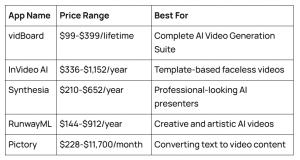Have you ever watched a video and wondered, “Wait, who actually made this?” Well, welcome to the fascinating world of faceless videos—where content seemingly creates itself, and humans take a back seat to artificial intelligence. I’ve been exploring this digital phenomenon for months now, and I’m honestly still amazed at how it’s transforming content creation.
Faceless videos are revolutionizing how we consume and create content online. Whether you’re an aspiring content creator who values privacy or an entrepreneur looking for efficient ways to produce engaging videos, understanding faceless content could be your ticket to digital success.
What Is a Faceless Video?
Simply put, a faceless video is content completely generated by AI without human intervention. Unlike traditional videos where a human host appears on screen or manually edits footage, faceless videos rely entirely on artificial intelligence to generate visuals, narration, and even storylines.
When I first discovered faceless content, I was sceptical. Could a machine really create compelling videos people would want to watch? The answer, it turns out, is a resounding yes.
Examples of faceless videos include:
- AI-narrated educational content with animated graphics
- Data visualization videos that transform complex information into engaging visuals
- AI-generated storytelling videos with computer-generated imagery
- Automated news summaries with stock footage and synthesized voiceovers
What makes faceless videos particularly interesting is that they don’t require a human to be present on camera, in the editing suite, or even in the creative process. The AI handles everything from concept to publication.
What is faceless content on YouTube?
Faceless content on YouTube refers to channels that publish AI-generated videos without revealing a human creator. These channels typically focus on niches like facts and information, data visualization, relaxation content, or educational material. The content appears seemingly out of nowhere, often with synthesized narration and computer-generated imagery.
Some viewers might not even realize they’re watching AI-created content, as the quality continues to improve dramatically. According to research on faceless marketing, this approach is becoming increasingly popular as it allows consistent content delivery without the limitations of human production schedules.
What is the faceless background?
The “faceless background” refers to the technological infrastructure that powers AI video generation. This includes:
- Machine learning algorithms that analyze existing content
- Natural language processing systems that create scripts
- Text-to-speech technology that generates narration
- Computer vision and rendering systems that create visuals
This invisible technological ecosystem operates behind the scenes to produce content that, until recently, would have required a full human production team.
How to Start Faceless Content?
Getting started with faceless video creation is simpler than you might think. I remember feeling overwhelmed at first, but breaking it down into steps made the process manageable.
Step 1: Choose Your AI Video Generation Platform
There are numerous platforms designed specifically for creating faceless videos. Popular options include:
- vidBoard
- InVideo AI
- Synthesia
- Pictory
- RunwayML
Each platform offers different capabilities, so it’s worth exploring a few before committing. Many offer free trials, which is how I first tested the waters. You can try vidBoard for free here.
Step 2: Select Your Content Niche
While AI can theoretically create content on any topic, successful faceless channels typically focus on specific niches. According to research on faceless YouTube channels, some of the most successful faceless niches include:
- Finance and investing
- Technology news and reviews
- History facts and stories
- Self-improvement tips
- Data-driven analysis
I’ve found that niches requiring factual information rather than personal opinion tend to perform better with faceless content.
Step 3: Generate Your First Video
Once you’ve selected your platform and niche, it’s time to create your first video. The typical process involves:
- Inputting a prompt or topic idea
- Setting parameters like video length, style, and tone
- Selecting voice types for narration
- Reviewing and approving the AI-generated content
- Downloading and publishing the final video
What surprised me most was how quickly the process works—videos that would take days to produce manually can be generated in minutes or hours.
Is Faceless Video AI Free?
One of the most common questions I hear is whether creating faceless videos is free. The answer is nuanced.
Free vs. Paid Options
While some basic AI video generation tools offer limited free tiers, most professional-quality faceless video creation requires a paid subscription. Free options typically come with significant limitations:
- Watermarks on the final video
- Restricted video length (often just 30-60 seconds)
- Limited access to voice options
- Fewer visual styles and templates
- Queued processing (slower generation)
In my experience, truly free AI video tools rarely produce content that can compete with paid alternatives. However, they can be useful for testing concepts before investing in premium services.
What is the app that makes faceless videos?
There isn’t just one app that makes faceless videos—there’s an entire ecosystem of them. Some of the most popular include:

These prices are always changing as the technology evolves and competition increases. When I started exploring faceless videos last year, prices were generally higher, so the trend seems to be toward greater affordability.
How to use AI on YouTube?
Implementing AI-generated content on YouTube follows a straightforward process:
- Create your content using an AI video generation platform
- Optimize the video with SEO-friendly titles, descriptions, and tags
- Upload to YouTube like any other video
- Monitor performance and use YouTube Analytics to refine future content
- Scale production as you identify what works for your audience
According to Sides Media, faceless YouTube channels can publish content more consistently than human creators, which is a significant advantage for algorithm performance.
Can Faceless Videos Make Money?
This is where things get interesting. Not only can faceless videos make money, but they can also be extraordinarily cost-effective to produce compared to traditional content.
How to make $10,000 per month on YouTube without making videos?
Earning significant income from faceless videos typically involves a multi-pronged approach:
- YouTube Partner Program revenue – Once you reach 1,000 subscribers and 4,000 watch hours, you can monetize through ads
- Affiliate marketing – Promoting products relevant to your niche
- Sponsored content – As your channel grows, brands may pay for mentions
- Digital products – Creating and selling information products related to your content
- Licensing content – Allowing other creators to use your AI-generated videos for a fee
The key to reaching the $10,000/month milestone is scale and efficiency. Since AI can produce content quickly, successful faceless channels often publish daily or even multiple times per day, maximizing revenue potential.
How much do YouTube shorts pay for 1000 views?
YouTube Shorts monetization works differently from traditional videos. Rather than paying per view, YouTube distributes revenue from the Shorts Fund based on engagement and viewer satisfaction. Generally, creators report earning anywhere from $0.01 to $0.05 per view on Shorts, meaning 1,000 views might generate $10-$50.
However, these figures vary widely based on:
- Your audience’s geography
- The topic of your content
- Viewer engagement levels
- Ad relevance to your content
I’ve found that faceless AI-generated Shorts can be particularly effective because they can be produced quickly enough to capitalize on trending topics, which often generate higher views and engagement.
Is it better to be a faceless YouTuber?
There are compelling advantages to running a faceless YouTube channel:
Privacy Protection: Your identity remains completely separate from your content.
Scalability: AI can produce content at volumes impossible for human creators.
Consistency: Content quality doesn’t fluctuate based on human factors like mood or energy levels.
Lower Production Costs: No need for cameras, lighting, or physical studio space.
Flexibility: You can pivot between niches or experiment with different content styles easily.
According to Adello’s research on faceless video ads, faceless content often performs better for certain objectives because it focuses viewers’ attention on the message rather than the messenger.
However, being a faceless YouTuber does come with challenges:
Connection Limitations: Building a personal connection with your audience can be more difficult.
Platform Uncertainty: YouTube’s policies regarding AI-generated content continue to evolve.
Competition: As the barriers to entry are lower, competition in the faceless content space is increasing rapidly.
In my opinion, whether it’s “better” depends entirely on your goals. If you value efficiency, privacy, and scalability over personal brand-building, faceless content may be ideal.
What is the Most Popular Faceless Channel?
Identifying the single most popular faceless channel is challenging because many don’t explicitly identify as AI-generated. However, several faceless channels have achieved remarkable success.
Top Performing Faceless YouTube Niches
Based on subscriber counts and view metrics, these niches consistently perform well with faceless content:
- Stock Market and Finance Analysis: Channels using AI to analyze market trends and present data visualizations
- Fact Compilation Channels: “Did you know?”-style videos sharing interesting facts with visuals
- Relaxation Content: AI-generated ambient sounds, meditation guides, and sleep stories
- Educational Animations: Complex concepts explained through AI-generated animations
- News Summaries: AI-generated breakdowns of current events
What makes these niches particularly successful is their focus on information rather than personality. Viewers come for the content itself, not to connect with a human creator.
Why do some YouTubers hide their face?
While traditional creators may choose to hide their faces for privacy reasons, faceless AI channels take this concept to its logical conclusion—eliminating the human element entirely. Some reasons traditional creators go faceless include:
- Protecting personal privacy
- Focusing attention on the content rather than their appearance
- Avoiding harassment or unwanted attention
- Creating a brand that can potentially be sold later
- Maintaining separation between online and offline lives
AI-generated faceless content addresses all these concerns by default, which is part of its growing appeal.
How to be a faceless vlogger?
Traditional faceless vlogging involves filming content without showing your face. With AI-generated faceless content, the approach is entirely different:
- Select an AI platform that specializes in narrative content
- Create a consistent “voice” for your AI narrator
- Develop a recognizable visual style that defines your brand
- Establish publishing patterns your audience can rely on
- Focus on data-driven content decisions rather than personal preferences
The most successful faceless AI vloggers I’ve studied take a methodical, almost scientific approach to content creation, letting performance metrics guide their strategy rather than creative instinct.
Conclusion: The Future of Faceless Video Content
As AI technology continues to advance at breakneck speed, we’re only seeing the beginning of what’s possible with faceless video content. The barriers between human-created and AI-generated content are blurring more each day, creating exciting opportunities for creators and businesses alike.
I believe we’re approaching a point where the distinction between “real” and “faceless” content will become increasingly irrelevant to viewers. What will matter is whether the content provides value, entertainment, or information—not who (or what) created it.
If you’re considering diving into faceless video creation, there’s never been a better time. The tools are becoming more accessible, the platforms are maturing, and the audience for this content continues to grow.
Whether you’re motivated by privacy concerns, efficiency, scalability, or simply curiosity about this emerging technology, faceless video creation offers an intriguing alternative to traditional content production.
The future of content may well be faceless—and based on what I’ve seen, that future looks surprisingly bright.





